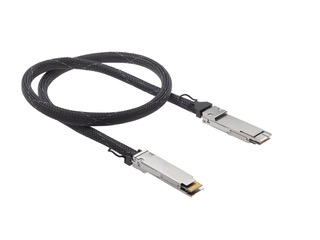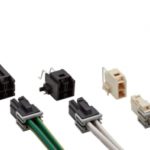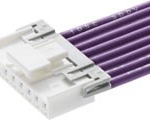Data centers are the backbone of today’s industries, providing a centralized facility for the servers, routers, switches, and interfaces that transform high-speed data streams. Essentially, these centers distribute and manage data between information providers and consumers — and the demand is growing for more data at higher speeds.
It’s predicted by 2021, global IP traffic will exceed 3.3 zettabytes. Historically, this is a 127-fold increase from 2005 data demand. What’s more: virtual reality, augmented reality, cloud-based services, and the Internet-of-Things (IoT) have entered the scene, requiring data-intensive capabilities. Add in the deployment of 5G and fiber-optic, last-mile delivery services and data centers have several advances to accommodate.
How these facilities can function seamlessly and excel is dependent on the available computing capabilities and installed networking equipment. Speed, capacity, and security are critical for success. In such an interconnected network, this means even the shortest cable is significant in terms of performance and cost.
Fortunately, certain manufacturers and distributors have recognized this and are already offering advanced, cost-effective cable options for data centers.
The cost of expansion
The use and deployment of data centers are not just for service providers and communications companies. Banks, traders, factories, universities, government, military, and other organizations build, use, and expand data centers for their own needs. Nearly all industries are experiencing exponential growth in data computing. According to a Data Center Knowledge report, the average number of facilities that large organizations manage is 8.1 — a number expected to grow to 10.2 over the next three years. Also, older, non-competitive data centers will be renovated (on average, 5.3 per organization) over the next 12 months.
These centers are also expanding in size to accommodate more infrastructure. The average-sized facility (which was between 5,000 and 50,000 square feet) is now typically built to hold 100,000 to 500,000 square feet. Over the next three years, 26 percent of the current data centers are expected to expand. This, of course, will require significant investments — for the real estate and the energy to power it.
Equipment is an additional consideration as technology advances. For example, smaller form factor and higher bandwidth fiber-optic, multi-channel transceivers are now packed more tightly into the modern equipment racks. This means thousands of fiber cables are used in small spaces and these top-of-rack-to-box, box-to-box, and cluster-to-cluster fiber links all require continuous monitoring and maintenance.
The is important because denser functionality generally equates to costly downtimes if a link fails. The more complex the equipment, the longer it may take to troubleshoot, diagnose, and fix or replace a faulty data link. To minimize downtime, it’s also essential to keep unique assemblies in-house or quickly find off-the-shelf replacement items from distributors.
None of these challenges are insurmountable but they do mean partnerships with reliable manufacturers or suppliers are critical.
The cost of cooling
The majority of data centers already share challenges and, at the top of the list, is the cost of energy. A recent report estimates that data centers consume between three and five percent of the world’s power.
The optimization of energy consumption at data centers is critical to reducing high operating costs but also for the environment. Companies are becoming significantly more aware of climate change and their environmental footprint.
The reason data centers use substantial power is, partially, to run the equipment but mostly for cooling. One of the largest expenses of running these facilities is the cost of the cooling systems for the servers.
The use of liquid-cooled racking offers one small solution as newer tensor processing units (TPUs) used in AI architectures exceed the limits of previous cooling technologies. Another idea that’s proving effective is replacing active fiber data links with a passive copper cable, which provides the same bandwidth. Unlike active fibers, passive copper cables contain no electrical components.
This is where innovative manufacturers, such as Molex, LLC, coupled with value-added logistical distributors, such as Heilind, are offering copper alternatives to new projects and legacy ones.
“As service provider networks grow, power consumption is becoming a bigger concern as it increasingly impacts profitability. Passive and active copper cables provide a clear path to reducing operational expenditures — both in existing architecture and on future deployments,” says Veronica Phillips, Sales Manager at Molex.
The benefits of cable
Hyperscale data centers (a facility owned and operated by the company it supports) were the first to benefit from copper cabling, which typically resulted in reduced cooling requirements, energy savings, and compounded savings over time. Such benefits also increased when a data center’s cabling was particularly dense. And, as smaller data centers expand or corporate data centers grow, the knowledge of these savings is flowing downhill.
Savvy planners know there are choices to be made when designing or expanding a data center. And all data centers share common problems. Cost and energy savings at the most granular level propagate. For example, replacing an active fiber data link with a passive copper cable that provides the same bandwidth, not only saves energy and reduces the need for more cooling, but provides compounded savings going forward.
Generally, copper cables offer faster speeds at longer distances and with more reliability than fiber. They tend to offer a lower total cost of ownership and can accommodate outdated legacy systems.
Research has shown that copper solutions are performance and price competitive with fiber. This is true for rack-to-rack and within-the-rack systems. One application, for example, is a single top-of-rack (TOR) aggregator that distributes data lines to servers below. In this case, link distances are short enough to be supported by a fully passive copper cable solution.
“As service providers continue to invest in network upgrades and average rates per user remain flat or fall, opportunities to reduce applied costs become more compelling,” adds Phillips. Interestingly, these passive solutions are far from new. Input/Output ports (such as SFP28, QSFP28, QSFP-DD, etc.) have always been developed with the option for copper cable. As early as the MSA for SFP, optical transceivers and DAC have been available, and this is still true for 400G solutions. What limited the use of copper use was the infrastructure that required longer links, so mostly fiber was deployed. Eventually, this simply became the norm for many networks — until recently.
Given the cost comparison with fiber, the energy savings (including zero losses when switching), the preference for copper connectivity is a smart one.
Take the purely passive copper interconnects from Molex, for example. Benefits include:
- Ability to achieve speeds of 400 Gbps
- Generate virtually no heat
- Require almost no active power
Additionally, longer runs can take advantage of Active Copper Cables (ACC), which draw 1.2 W of power compared to optical transceivers that consume and dissipate 12 W of power — a net savings of more than 10 watts per port.
What’s more: the impressive speed of Molex’s passive copper cables. They comply with MSA, IEEE, and SFF architectures. Also, the new direct attach cables (DACs) for data centers, such as QSFP28 and QSFP56, are small, form-factor pluggable interconnect solutions that achieve data rates up to 200 Gbps. The QSFP-DD can handle 400 Gbps.

“Hyperscale customers are already taking advantage of the savings in operation, and Capex costs by using DAC and ACC (Active Copper Cables described below) solutions for in-the-rack or rack-to-rack applications”, explains Dan Wandolowski, Group Product Manager at Molex.
The DAC passive copper family is available up to three meters in length. An active family of copper interconnects, the ACC family is available with lengths up to 10 meters.
Active Copper Cables use internal linear amplifiers in the assemblies to boost the signals. This extends the length of the cables and provides low latency. It also requires less power and at lower costs than fiber-optic options. Essentially, Active Copper Cables perform as passive cables without the need for configuration or interaction with the host. Much like the DAC, they are truly “plug-and-play,” requiring no re-timing.
What’s more: these form factors will support the performance of the upcoming 112 Gbps speeds, allowing facility managers and supply chain partners to plan the next-generation facilities required for Hyperscale and cloud-based data management.
The value of distributors
Although it’s possible to forge direct relationships with manufacturers, distribution services can provide added value to customers, offsetting the cost of acquisition and ownership. Often, better pricing is available since bulk quantities can be ordered and stocked at the distributor locations and shipped as needed or on a set schedule.
A value-added distributor, such as Heilind Electronics, provides fast-turn inventory assurance and reduce warehousing and operating costs.
With quick availability of off-the-shelf assemblies, data center operators can take advantage of redundancies from a distributor while thoroughly tested replacement (or expansion) parts are on their way. This reduces downtime because it’s unnecessary to wait for the next manufacturing run. Also, in-house buyers no longer have to seek out parts from non-local or domestic sources at random costs.
Especially with new facilities and expansions planned, potentially better pricing is available since bulk quantities can be ordered and stocked at the distributor locations and shipped as needed or on a set schedule.
Conclusion
Legacy and newly planned data centers and communication hubs can take advantage of copper cables to reduce heat, power, and cooling costs. Copper solutions carry many benefits compared to similar links deployed in fiber. Value-added distribution provides a valuable resource to help keep legacy data centers up and running and to manage inventory as new facilities are built.
Molex is an industry leader in designing and manufacturing highly reliable and innovative electronic interconnect solutions for generations. Heilind Electronics is a value-added distributor of interconnect and sensor products poised to provide off-the-shelf inventory of thoroughly tested Molex fiber replacement cable assemblies.
Keep both of these industry leaders in mind while maintaining your current data center — and planning your next.



Leave a Reply
You must be logged in to post a comment.